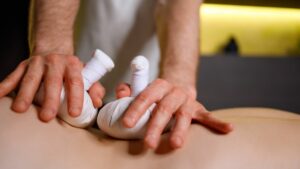Thai foot massage has been an ancient therapeutic technique for centuries to promote relaxation and relieve stress. This practice has gained popularity recently due to its effectiveness in treating various ailments and promoting overall wellness.
In this article, we will explore the origins and history of Thai foot massage, how it works, and its many health benefits. We will also provide a step-by-step guide on performing Thai foot massage and offer tips on finding a qualified practitioner.
Whether you are a seasoned massage therapist or simply looking to improve your well-being, Thai foot massage is a practice worth exploring.

Origins and History of Thai Foot Massage
Thai foot massage, also known as reflexology, originated over 2000 years ago in Thailand. It is believed to have been introduced by Buddhist monks who brought the practice from India.
Thai foot massage is based on the principle that there are energy pathways, known as “Sen,” in the feet connected to different body parts. By applying pressure to these Sen lines, the therapist can stimulate the body’s natural healing process and promote overall well-being.
Over time, this massage has evolved into a more complex practice incorporating Chinese reflexology and Japanese shiatsu elements. Thai foot massage was traditionally used as a therapy for the elderly, pregnant women, and those with physical limitations.
Today, Thai foot massage has become a popular alternative treatment worldwide and is recognized for its ability to promote relaxation, reduce stress, and alleviate pain.
How This Massage Works
Thai foot massage applies pressure to specific points on the feet that correspond to different body parts. The therapist uses their fingers, thumbs, and palms to stimulate the Sen lines and release any blockages in the energy pathways.
This helps to improve circulation, increase flexibility, and promote the body’s natural healing process.
In addition to stimulating the Sen lines, Thai foot massage also involves stretching and manipulating the feet and ankles. This helps improve the range of motion, reduce muscle tension, and promote relaxation.
Thai foot massage is based on the principle that the feet are a microcosm of the body, with each part of the foot corresponding to a specific organ or body part. By massaging the feet, the therapist can help to bring balance and harmony to the body as a whole.

Health Benefits of Thai Foot Massage
Thai foot massage offers a wide range of physical and mental health benefits. Here are some of the most notable ones.
Reduces Stress and Anxiety
Like many other massages – the hot stone massage and Swedish as prime examples – the Thai foot massage also has a calming effect on the body. This helps to largely reduce any stress and anxiety being felt.
Improves Circulation
By stimulating the Sen lines, this massage helps improve circulation throughout the body, which can positively impact overall health. This ensures that blood and oxygen flow freely throughout the various parts of the body, helping organs function properly, heal wounds faster, and many more.
Alleviates Pain
Jumping off from the previous point, a Thai massage aimed at the feet can also help to alleviate pain in these areas.
Pain in body parts such as the feet, ankles, and lower legs can be fixed. Apart from the lower body though, this foot massage’s pain alleviation can also affect other body parts.
Boosts Immune System
Regular Thai foot massage has been shown to boost the immune system, helping the body better fight infections and illnesses.
Enhances Mental Clarity
While the brain is far from one’s feet, this massage can also help to improve mental clarity and focus, reducing brain fog and promoting overall well-being.
Research has also shown that Thai foot massage can effectively treat specific conditions, such as plantar fasciitis, neuropathy, and arthritis.

Preparing for a Thai Foot Massage
- Hydrate – Drink plenty of water before your massage to help flush out any toxins released during the massage.
- Dress Comfortably – Wear loose, comfortable clothing that allows easy access to your feet and ankles.
- Communicate With Your Therapist – Let your therapist know about any health conditions or concerns, your preferences for pressure, and areas to focus on.
- Be Mindful of the Timing – Avoid eating a heavy meal or drinking alcohol before your massage, as this can make you uncomfortable during the session.
- Take it Easy Afterward – After your massage, take some time to relax and let your body fully absorb the benefits of the treatment.
Following these tips can prepare you for a relaxing and effective experience.
How to Perform a Thai Massage For the Feet
- Start With a Warm-up – Before the massage, warm up the feet and ankles by soaking them in warm water for 10-15 minutes.
- Apply pressure – Use your fingers, thumbs, and palms to apply firm pressure to the Sen lines on the feet. Start at the base of the toes and work down to the heel.
- Stretch the feet – Hold the heel with one hand and use the other hand to stretch the foot upwards, towards the ankle. Repeat on the other foot.
- Manipulate the toes – Use your thumbs to gently rotate and manipulate each toe, starting with the big toe and working to the smallest toe.
- Finish with a cool-down -After the massage, finish with a cool-down by placing the feet in cold water for a few minutes to help reduce any inflammation.
These techniques can be used to perform an essential Thai foot massage at home. However, for more advanced and effective treatment, it is recommended to seek out a trained practitioner.
Stimulating the Sen For Overall Well-Being
Thai foot massage is a powerful and effective alternative therapy offering numerous physical and mental health benefits. With its roots in ancient Thai culture, this practice has been refined over thousands of years and has become a popular form of massage therapy worldwide.
By stimulating the Sen lines in the feet, Thai foot massage can help to promote relaxation, reduce stress, alleviate pain, and improve overall well-being.
Whether you receive a massage from a trained practitioner or perform the techniques on yourself or a loved one, Thai foot massage is a valuable tool for promoting health and wellness.



